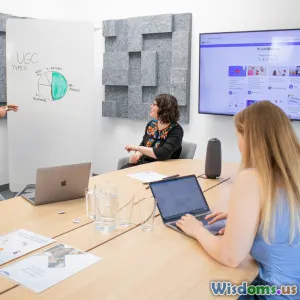
Why Architects Need Coding Skills Now More Than Ever
14 min read Discover why coding is now a vital skill for architects, transforming design, collaboration, and innovation in modern architecture. (0 Reviews)
Why Architects Need Coding Skills Now More Than Ever
Introduction: The Blueprint is Changing
Imagine an architect poised above a drafting table, a crisp blueprint unfurling beneath their hands, and a world of possibility taking shape in gentle pencil strokes. Fast-forward to today—a digital workstation, screens aglow with complex geometries, live simulation models, and lines of code transforming creativity into tangible reality.
The architectural profession is in the midst of a technological renaissance. Design software, automation, and data-driven modeling have fundamentally changed how architecture is envisioned, communicated, and executed. Amid these seismic shifts, a new essential tool has emerged: coding. Much like the ability to render a flawless sketch, coding now empowers architects to push boundaries, streamline workflows, and interact with their profession in unprecedented ways. The age-old symmetry of technical skill and artistic vision finds a new balance—one increasingly dictated by lines of code.
Let’s explore why, in 2024 and beyond, coding isn’t a niche hobby for architects, but a powerful, career-defining skill they can’t afford to ignore.
The Digital Evolution of Architecture
From Drafting Boards to Digital Design
For centuries, architects relied on hand-drawn plans and physical models to communicate their ideas. The arrival of Computer-Aided Design (CAD) in the 1980s revolutionized the process, allowing precision and efficiency-building digital models that were easier to tweak, share, and reproduce.
In the decades since, the tools have evolved rapidly—Building Information Modeling (BIM) platforms like Autodesk Revit and Rhino, parametric design software such as Grasshopper, and virtual reality-based project reviews have all entered mainstream practice. The evolution continues, integrating artificial intelligence (AI), generative design, and automation directly into daily workflows.
Key Stat: According to Allied Market Research, the BIM market alone is projected to reach USD 15.06 billion by 2027—an explosive indicator of the ongoing digital transformation of the profession.
Coding: The New Architectural Language
What distinguishes recent digital advances is the central role of customization: instead of one-size-fits-all tools, architects can script unique solutions, manipulate data, and design interactive environments, all with code. The language of buildings now dovetails with languages like Python, JavaScript, and C#—and this convergence opens up dramatic new opportunities.
Section 1: Automating the Mundane—Efficiency Unleashed
Why Waste Time on Repetitive Tasks?
Every architect has experienced the “grunt work” that accompanies creativity: renaming thousands of drawing layers, organizing schedules, running repeated calculations. While these are essential, they’re also time sinks, often done manually or through cumbersome point-and-click software interfaces.
How Coding Helps:
Coding allows for the automation of repetitive (and often frustrating) tasks.
- Scripting for Revit: Dynamo (a visual programming environment for Revit) and Python scripts can batch update sheet names, automate space planning, and even optimize material takeoffs within minutes instead of days.
- Automated Drawing Generation: Scripts in Rhino and Grasshopper can produce complete sets of drawings from a single parametric model, instantly reflecting design iterations.
Real-World Case: Veronica Barrios, a London-based architect, used Python to automate routine cost estimations for complex mixed-use buildings, reducing errors by 70% and freeing up nearly 8 hours a week—time she could now devote more fully to design innovation.
Unlocking Productivity and Reducing Errors
Automation not only saves time; it minimizes error—manual data entry or copying details between systems is prone to mistakes, which can be financial landmines further down the line. By automating with code, architects ensure consistency and accuracy, making their teams more resilient and their projects more robust.
Section 2: Parametric and Generative Design—Unlocking Creative Potential
What is Parametric Design?
Parametric design enables architects to generate complex geometries based on adjustable input parameters, rather than rigid manual drafting.
Example: With Grasshopper for Rhino, an architect can:
- Modify window size, orientation, or sun-shading in real time across an entire facade
- Instantly visualize hundreds of variations before choosing the optimal one
Such dynamic, rule-based modeling is powered by scripting and algorithmic logic—without coding know-how, these capabilities remain out of reach.
Generative Design and AI: The New Frontier
Generative design, which employs algorithms to produce a wide range of solutions based on specified constraints (such as material, light, or budget), is fast becoming an industry staple. Autodesk’s generative design tools, for example, allow you to input goals (like maximizing daylight and minimizing material cost), and the algorithm generates thousands of possible design options.
Fact: Foster + Partners used custom Python scripts for daylight optimization in the Bloomberg European Headquarters, one of the world’s most sustainable office buildings.
Creative Control at Your Fingertips
Coding doesn’t replace creativity; it supercharges it. Those who understand scripting can mold digital tools to enhance their design intent, not just accept preset software outcomes. It creates a feedback loop—code helps architects explore ideas more deeply, and the exploration, in turn, informs new scripts.
Quote:
“One of the best things scripting has done for us as architects is to make our tools serve our ideas, not the other way around.”
—Marc Fornes, THEVERYMANY
Section 3: Data-Driven Design and Sustainability
Data is the New Drawing
Buildings today generate and consume data at unprecedented scales. Architects increasingly rely on building performance data (energy, light, air flow) to inform design. This data-driven approach is essential for sustainability and certifications like LEED and WELL.
How Coding Empowers Data-Driven Design:
- Real-Time Analysis: Scripting connects BIM models to analysis engines (like Ladybug & Honeybee for environmental studies) to test energy use, daylighting, or climate response.
- Optimization Through Algorithms: Architects can write scripts for iterative analyses—automatically adjusting design elements and optimizing for energy, daylight, or even wind tolerance.
Example: Zaha Hadid Architects used advanced parametric modeling and environmental analysis scripting to optimize the Beijing Daxing International Airport, achieving significant energy savings.
Quantified Impacts: Toward True Sustainability
With code, you can:
- Simulate how insulation changes affect carbon footprint, instantly modifying digital prototypes
- Track embodied energy via automated material logs
- Visualize lifecycle performance for smart decision-making beyond aesthetics
The result? Designs that aren’t just beautiful, but sustainable to their core—backed by hard numbers, tested theories, and easily adaptable to new eco-standards.
Section 4: Enhanced Collaboration and Interdisciplinary Workflows
Breaking Down Silos Across Disciplines
Today’s architectural projects are rarely lone endeavors. Engineers, fabricators, and even AI specialists frequently join collaborative teams. Coding enables architects to:
- Exchange data in common formats (like JSON, XML, IFC), smoothing communication between diverse software platforms
- Develop custom tools and plugins to connect, automate, and synchronize workflows
Open Source and the Dawn of Custom Tools
Open-source initiatives (like Speckle and BlenderBIM) have flourished, allowing teams to build exactly what they need. For example, large architecture firms routinely develop in-house Grasshopper plug-ins to link climate simulation tools or automate clash detection—all driven by internal scripting proficiency.
Industry Fact: As per a survey by the Royal Institute of British Architects, over 41% of practices now customize at least part of their software environment in-house, up from just 24% a decade ago.
Real-World Impact: Collaborative Coding in Practice
- Digital Twins: Code allows live integration of architectural design with operational data (energy, occupancy), fast becoming vital for smart-cities initiatives
- AR/VR Prototyping: Custom scripts drive interactive models for virtual reality walkthroughs with clients
Section 5: Staying Competitive—Jobs, Entrepreneurship, and the Future
The Employers’ Perspective: Coding is a Distinct Edge
Today’s jobs market favors architects who bridge art, engineering, and technology. Coding proficiency isn’t “nice-to-have”—it’s increasingly a vital differentiator:
- Hiring Trends: Job listings for positions at major firms (Gensler, KPF, Foster + Partners) increasingly require experience with Python, C#, or visual scripting tools (like Dynamo, Grasshopper)
- Expanded Roles: Architects with coding experience are moving into computational design director positions, R&D leadership, or even launching tech startups focused on architecture solutions
Data Point: According to Architecture 2030, nearly 50% of graduating architects in 2023 report advanced digital and coding skills as the top factor in employment offers and career growth.
The Entrepreneur’s Toolkit—Beyond Traditional Practice
For the enterprising architect, coding unlocks startups, consultancy, and software development prospects.
Examples:
- Allplan’s Marie Le Duff started a consulting firm building Grasshopper plugins for urban planning
- Code-architecture platforms like Hypar, founded by former architects, automate architectural logic for mass housing or office blocks—reducing concept design from months to minutes
Section 6: Learning to Code—Resources and Practical Strategies
Choosing the Right Language and Tool
Not every architect needs to be a computer scientist—most benefit massively from a working knowledge of:
- Python: For scripting in Rhino/Grasshopper, Autodesk Dynamo, and standalone automation
- **C#/**JavaScript: For creating plugins and more advanced customizations in Revit/BIM toolkits and web-based architecture apps
Free and Accessible Resources:
- Rhino Developer Docs
- Grasshopper3D Community
- Dynamo Primer
- MOOCs: Coursera's "Programming for Architects," LinkedIn Learning courses
- YouTube channels like Parametric House or Designalyze
Realistic Roadmap: From Novice to Pro
- Automate a task: Start by scripting a small routine in Dynamo or Grasshopper
- Join a community: Online forums are invaluable for free help
- Document results: Tracking time saved, errors avoided, or design options generated can rapidly show coding’s value to a firm or team
Conclusion: The Foundation for Future-Proof Practice
Coding is no longer optional, or reserved for the “techies” on a design team. For today’s architects, coding is the thread that ties innovation, efficiency, and competitive advantage together. It automates the tedious, expands creative horizons, and weaves data-savvy sustainability into the heart of every building.
Whether you’re a student, a seasoned designer, or an entrepreneur, investing in coding isn’t just a career booster—it's a toolset that lights the way toward better, smarter, and more impactful architecture for years to come. The blueprint for the next era is being drafted not just in pens and pixels, but in code. Will your practice keep pace?
Further Reading & Resources
- Daniels, Tom. Parametric Design for Architects. Birkhäuser, 2022.
- Royal Institute of British Architects (RIBA): Digital Transformation Survey 2023
- Ladybug Tools Documentation: https://docs.ladybug.tools/
- "How Architects Use Coding" – ArchDaily, 2024
Rate the Post
User Reviews
Other posts in Architectural Education
Popular Posts

















